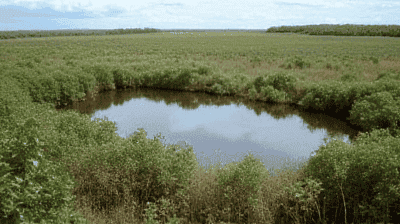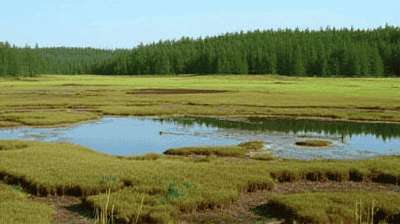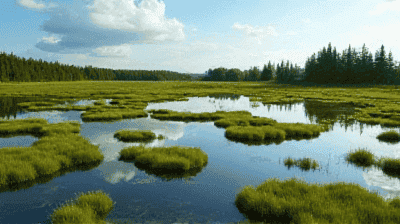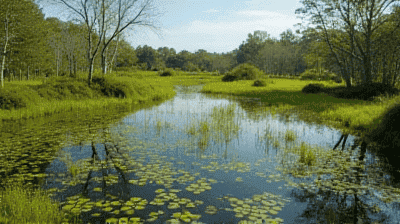
Peatlands, often overlooked in discussions about climate change, are among the most important ecosystems on the planet. These waterlogged areas, which are primarily found in boreal, temperate, and tropical regions, act as critical carbon sinks, storing more carbon than all the world’s forests combined. As we face a climate crisis driven by greenhouse gas emissions, understanding the role of peatlands in carbon sequestration—and the alarming rate at which we are losing them—has never been more crucial.
Peatlands are wetland ecosystems characterized by the accumulation of peat, a type of organic matter composed of partially decayed plant material. This accumulation occurs in waterlogged conditions that slow down decomposition, allowing organic matter to build up over thousands of years.
There are two main types of peatlands:
Bogs: These are acidic, nutrient-poor peatlands that receive water primarily from precipitation. They are often characterized by a specific type of vegetation, including sphagnum mosses, heathers, and certain shrubs.
Fens: Unlike bogs, fens receive water from groundwater and are typically less acidic and more nutrient-rich. They support a wider variety of plant species, including sedges and other herbaceous plants.
Peat formation is a complex process influenced by several factors, including climate, hydrology, and vegetation. Here’s how it generally occurs:
Waterlogged Conditions: Peatlands form in areas where water accumulates, creating waterlogged conditions that inhibit the decomposition of plant material.
Plant Growth: As plants grow and die, their remains are partially decomposed by microorganisms. However, in waterlogged conditions, decomposition is slowed, leading to the accumulation of organic material.
Carbon Storage: Over time, this accumulation of organic matter forms peat, effectively locking away carbon that would otherwise be released into the atmosphere as CO2.
The carbon storage capacity of peatlands can be immense; while they cover only about 3% of the Earth’s land surface, they contain approximately 30% of the world’s soil carbon.

Peatlands play a vital role in regulating the global carbon cycle. Through the process of photosynthesis, plants in peatlands absorb carbon dioxide from the atmosphere. When these plants die, the carbon they stored remains in the peat instead of being released back into the environment. This natural process makes peatlands key players in climate regulation.
Carbon Storage: The carbon stored in peatlands can take hundreds to thousands of years to accumulate, meaning that they represent a significant long-term carbon reservoir.
Mitigating Climate Change: By sequestering large amounts of carbon, peatlands help mitigate climate change. Preserving and restoring these ecosystems can be an effective strategy in reducing atmospheric CO2 levels.
Biodiversity Hotspots: Peatlands support unique plant and animal species, many of which are specially adapted to the anaerobic conditions of these ecosystems. This biodiversity also contributes to the overall resilience of these areas against climate impacts.
To understand the impact of peatlands on the global carbon balance, it's crucial to consider both carbon storage and release.
It is estimated that human activities have released around 1 billion tons of CO2 per year from drained peatlands, contributing to climate change.
Peatlands are found across various regions of the world, with significant concentrations in:
While peatlands are critical to carbon storage, they are facing unprecedented rates of degradation due to a variety of human activities:
Agricultural Expansion: Peatlands are often drained for agricultural purposes, such as oil palm and rice cultivation. Drainage not only reduces the peat's ability to sequester carbon but also leads to the release of historical carbon stores.
Land Use Changes: Urbanization and infrastructure development threaten peatlands through drainage, land clearing, and soil compaction.
Logging and Extraction: Commercial logging for timber and extraction of peat for fuel and horticulture contribute to the degradation and destruction of these vital ecosystems.
In addition to direct human impacts, climate change presents a dual threat to peatlands:
Altered Hydrology: Changing precipitation patterns and rising temperatures can disrupt the delicate hydrological balance of peatlands, affecting their ability to sequester carbon.
Increased Wildfire Risk: Drained peatlands are more susceptible to fires, which can release vast amounts of carbon in a short period. Peat fires can be particularly devastating, producing large amounts of CO2, particulate matter, and other pollutants.

The loss of peatlands significantly contributes to climate change. As previously mentioned, draining and degrading peatlands releases stored carbon, essentially turning them into sources of greenhouse gas emissions. This feedback loop exacerbates global warming, making it increasingly challenging to meet climate targets.
Peatland degradation leads to the loss of unique flora and fauna that depend on these ecosystems. The encroachment of agriculture and urban development can eliminate habitats for specialized species, leading to declines in biodiversity.
Endangered Species: Many plant and animal species that thrive in peatlands are already at risk due to habitat loss. For example, certain orchid species, carnivorous plants, and unique invertebrates are sensitive to changes in their wetland environments.
Ecosystem Services: The degradation of peatlands can diminish their ability to provide other ecosystem services, such as water filtration, flood regulation, and recreation opportunities, further impacting local communities.
The economic implications of peatland degradation extend beyond environmental concerns:
Fisheries and Agriculture: The loss of healthy wetlands can impact local fisheries and agricultural productivity, which many communities depend on for their livelihoods.
Tourism: Many peatlands are important for eco-tourism, attracting visitors interested in their unique biodiversity. Their degradation can lead to a decline in tourism revenue.
Increased Carbon Costs: As carbon emissions rise due to peatland loss, countries may face higher costs for carbon credits and penalties as they strive to meet international climate commitments.
Conserving existing peatlands through protective measures and sustainable management practices is crucial:
Legal Frameworks: Governments can implement policies and regulations that protect peatlands from degradation. Legal protections can involve establishing conservation areas and implementing strict regulations on land use.
Sustainable Practices: Promoting sustainable land use practices in surrounding areas can help reduce the pressure on peatlands. For instance, agroforestry and sustainable agriculture techniques can be used to maintain peatland health while still supporting local economies.
Restoration of degraded peatlands is vital for recovering their carbon storage capacity and biodiversity. Key restoration techniques include:
Re-wetting Drained Peatlands: Re-establishing the natural hydrology of drained peatlands is essential for restoring their function as carbon sinks. This often involves blocking drainage ditches and reinstating water levels.
Replanting Native Vegetation: Planting native species that thrive in peatland environments can help restore plant communities and revitalize the ecosystem.
Monitoring and Adaptive Management: Ongoing monitoring of restored areas is essential to track progress and adapt management strategies based on outcomes. This can involve assessing plant growth, carbon storage, and biodiversity recovery over time.
Engaging local communities in peatland conservation efforts is critical for success:
Local Knowledge: Involving local stakeholders, including Indigenous populations, can provide valuable insights into sustainable practices and promote stewardship of peatland resources.
Awareness Campaigns: Educating the public about the importance of peatlands and the impacts of degradation can foster a sense of responsibility and drive conservation initiatives.
Participatory Restoration Projects: Community-led restoration projects can empower local populations to take ownership of peatland conservation, combining traditional knowledge with modern practices.
Investing in research and fostering international cooperation are essential for effective peatland management:
Scientific Research: Increased funding for scientific studies on peatlands can enhance our understanding of their dynamics, enabling better management practices. Research on the ecological functions of peatlands, their responses to climate change, and effective restoration techniques is crucial.
Global Initiatives: Collaborative efforts like the Global Peatlands Initiative bring together governments, NGOs, and private sectors to promote the sustainable management and restoration of peatlands worldwide. Shared experiences and best practices can help improve localized efforts.

The world's peatlands are critical carbon sinks that play an essential role in climate regulation, biodiversity conservation, and the provision of ecosystem services. However, they are under significant threat from human activities and climate change, causing alarming rates of degradation and loss. The implications of this degradation extend beyond the environmental realm, impacting local economies, livelihoods, and global climate stability.
Addressing the silent crisis of peatland loss requires a multifaceted approach that includes the protection of existing ecosystems, the restoration of degraded peatlands, community engagement, and international cooperation. By recognizing the value of peatlands, investing in their conservation, and taking meaningful actions to restore and protect them, we can make significant strides toward mitigating climate change and preserving these vital ecosystems for future generations.
The urgency of action cannot be overstated; as stewards of the planet, we must prioritize the conservation of peatlands, ensuring they continue to function as critical carbon sinks and biodiversity havens amidst a changing climate.